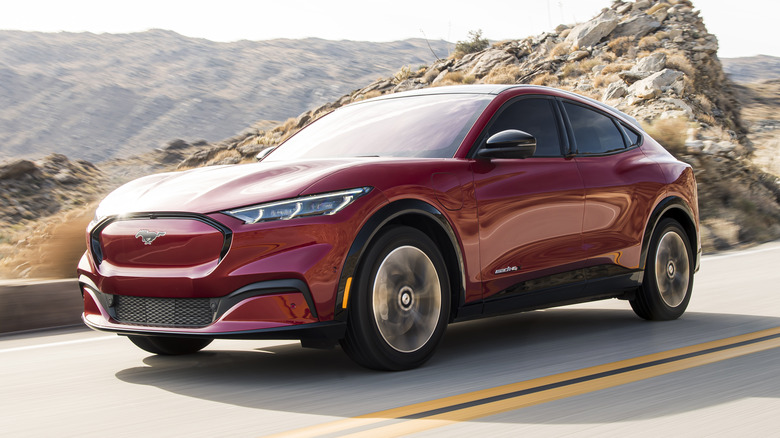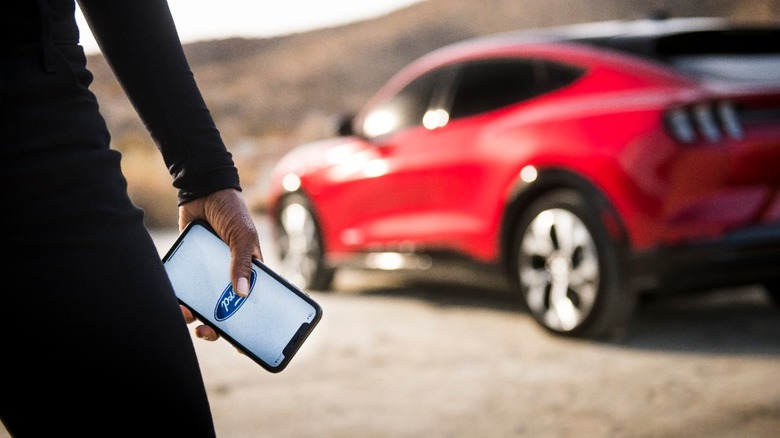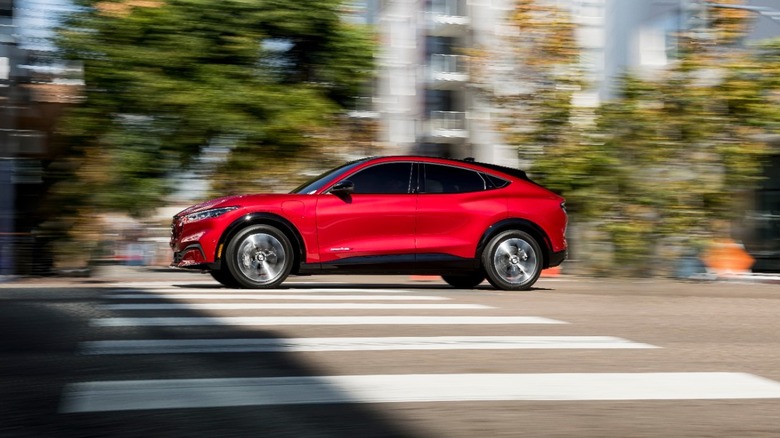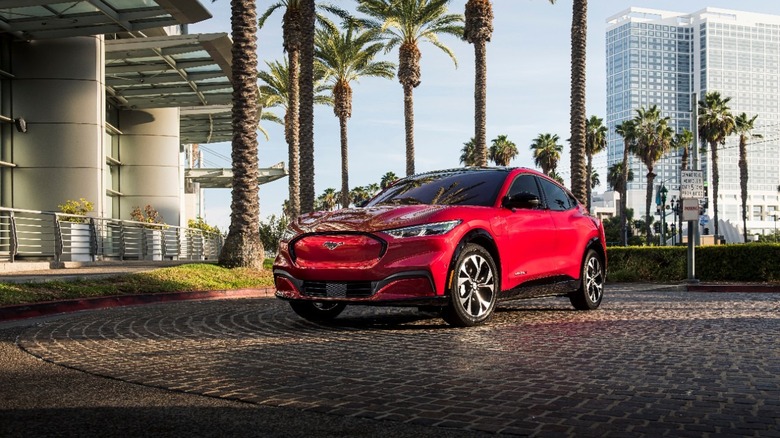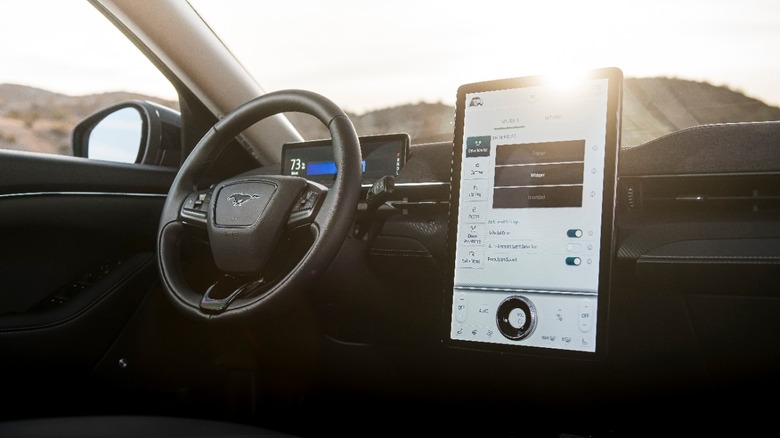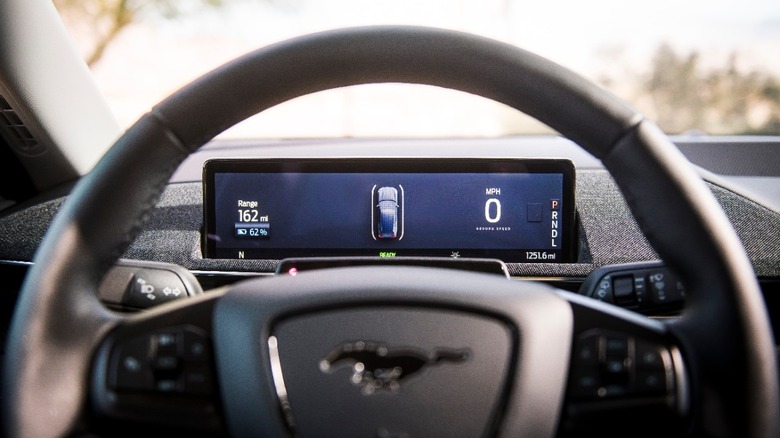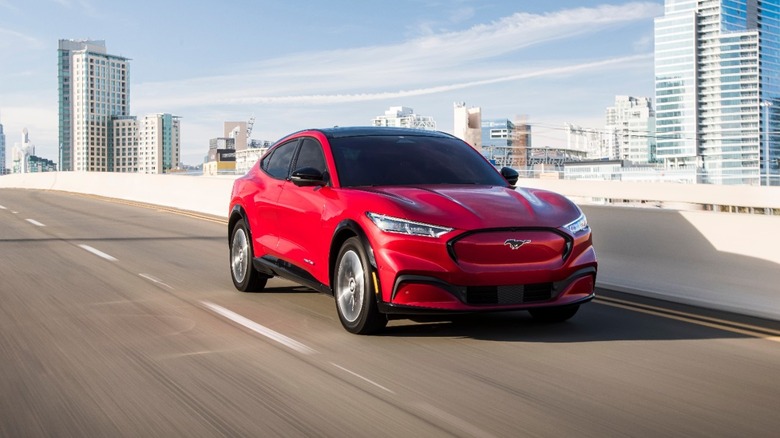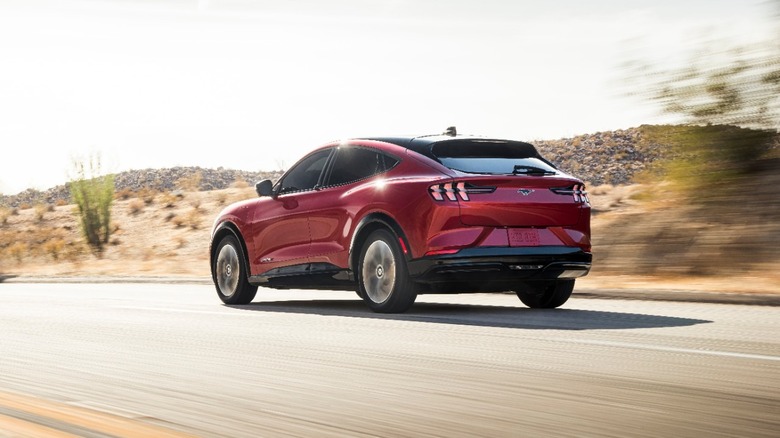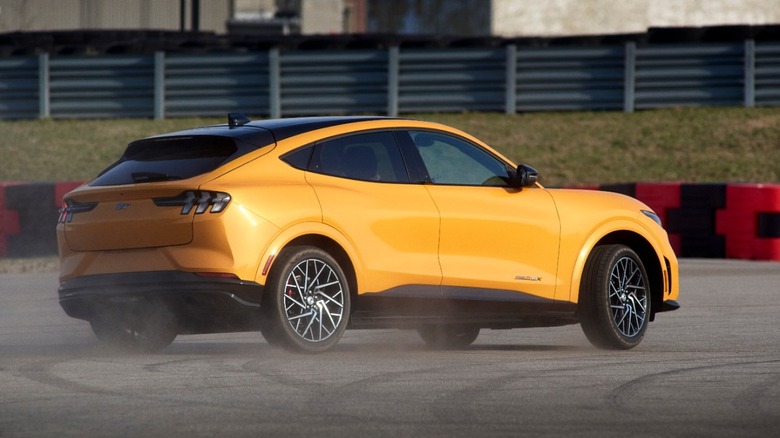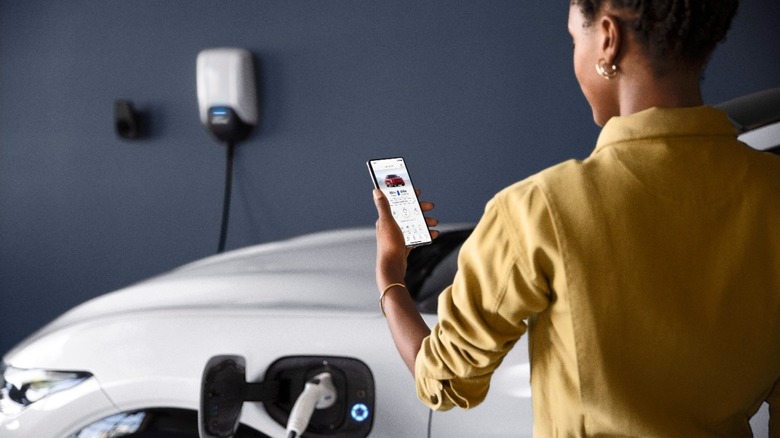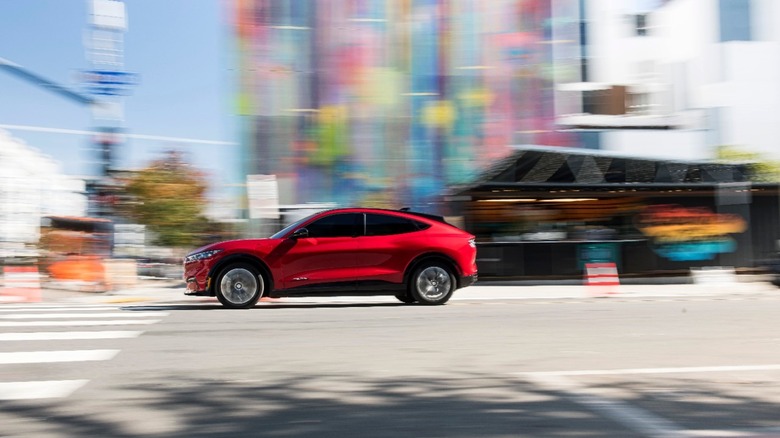Ford Mustang Mach-E: 10 Features That Will Change How You Use Your EV
As the first EV to wear the venerable Ford Mustang nameplate, the Mach-E had a lot to live up to. Much like the gas-powered Mustang, the Mach-E sets out to bring affordable performance to the masses, and in general, it's very likable to drive. It's not just a simple crossover with an electric motor, though — Ford has taken a leaf out of Tesla's book and packed the Mach-E with a host of innovative functions and features.
Some of those features can be easy to miss if you don't know they're there, but they might just change the way you use your EV day-to-day. While the Mustang Mach-E can't claim to sport "Full Self-Driving" or have access to Tesla's Supercharger network, its built-in features offer alternatives to both of those systems and much more. The EV market is beginning to get crowded as more manufacturers launch their own electric vehicles, but these features help the Mustang Mach-E stand out from the rest.
FordPass Remote Vehicle Setup
Downloading the FordPass app enables you to use your phone for a variety of functions, and one of the most useful is the Remote Vehicle Setup function. This enables you to customize certain functions before your vehicle is even delivered — things like setting your climate control preferences, entering navigation destinations like home and work, and radio presets. When your vehicle is delivered, you can simply connect it to the app to transfer all of these settings over immediately, so your car will be set up just how you want it from the first time you drive it.
With the same app, you're also able to lock and unlock your car without needing your key fob. This isn't a feature unique to Ford — plenty of other automakers including Tesla and BMW also offer similar functionality. However, if you're upgrading from an older car to the Mustang Mach-E, it can be an easy feature to miss.
FordPass Power My Trip
Another useful FordPass feature is Power My Trip, which attempts to solve one of the biggest concerns that many buyers have about EVs in general. Running out of power mid-way through a long journey is an unavoidable inconvenience for many EV drivers, especially those driving cars with shorter ranges. The 2023 Mustang Mach-E gets between 224 and 312 miles on a single charge, depending on the trim you buy. Any journeys longer than that, and you'll have to stop off somewhere to top up.
This is where Power My Trip comes in: if you enter a destination in the navigation that's further away than the estimated amount of range you have remaining, the car will automatically incorporate fast charging points into the route where possible. You'll still have to deal with the inconvenience of waiting for the battery to recharge and, as SlashGear found in its review of the Mustang Mach-E, deal with certain fast chargers simply not working, but at least you won't have to find them yourself.
Over-the-air software updates
The Mustang Mach-E's software is kept up to date through a stream of over-the-air updates, which can include patches and tweaks to the system or even add entirely new features without the driver having to do anything. The system was first popularized by Tesla, but since then, a number of other manufacturers have also unveiled their own versions, with the aim of keeping EVs cutting-edge over a longer period of time.
Tesla has recently proved that over-the-air updates are useful in ways you might not expect, for example when an NHTSA recall was issued over safety concerns with certain cars' window closing mechanisms. Instead of needing to take the car into a service center to be fixed, owners simply had to wait for an over-the-air software fix to be installed, and then carry on as usual. It's a much simpler and more efficient way of conducting recalls, and Ford should be able to make full use of the Mustang Mach-E's over-the-air capabilities if a recall of this nature is ever needed in the future.
15.5-inch central touchscreen with SYNC 4A
One of the most clearly Tesla-inspired parts of the Mustang Mach-E is the large, rectangular touchscreen that sits between the driver and the passenger and controls nearly all the car's features and functions. It runs on Ford's SYNC 4A infotainment system, and it is generally intuitive once you got used to the menus, trays, and views. The car is not completely without physical buttons and knobs, though — there's still a volume/temperature knob integrated into the bottom of the touchscreen, a drive mode selector, and a few controls on the steering wheel.
The touchscreen is positioned to appear as if it's floating out from the dash, making it easy to reach for the driver. While it won't be anything unusual for anyone who's previously driven a Tesla, having such a large, prominent screen in the cabin can be distracting if you're not used to it. The infotainment system will continue to evolve over time as Ford pushes out updates, so expect even more functions to be available in the near future.
Intelligent range
Especially if you're somewhere where fast charging points aren't too common, it can be easy to get anxious about whether your car's displayed range is accurate or not. Ford aims to dispel those fears with its intelligent range feature, which takes into account things like external temperature and driving conditions to give you a more accurate picture of how much juice you have left. The feature is continually updated as Ford continues to refine its prediction software, so it should get even more accurate as time goes on.
As the number of EVs on the road continues to rise and more infrastructure is implemented, it's likely that range anxiety will become less of an issue for most drivers anyway. But until then, it's good to see that Ford is working on directly addressing one of the biggest complaints that EV skeptics often cite as barriers to adoption, even if displaying accurate range alone is only part of the solution.
BlueCruise semi-autonomous driving
Ford's BlueCruise driver assistance technology isn't quite as advanced as rival systems from Tesla or GM, but it recently received an update that should help even the playing field a little. Version 1.2 of the software includes automatic Lane Change Assist, which allows the Mustang Mach-E to switch between lanes on the highway after the driver confirms the move by tapping the indicator stalk. This works in both hands-on and hands-off mode, although hands-off mode is only available on certain pre-mapped highways that Ford refers to as "Blue Zones."
Lane Repositioning is another new feature that enables the car to move about within its lane to keep a safe distance from larger vehicles, such as a semi-truck. Sometimes, the movement can be as little as a few inches either way, but when the car moves a more significant amount, a graphic appears on the screen to inform the driver of what's happening. A new Predictive Speed Assist feature also helps the system display more human-like behavior when cornering. Other than that, BlueCruise remains as it was previously, combining adaptive cruise control functions with lane-keeping to make life easier for the driver during everyday journeys.
CoPilot360 safety tech
As well as offering a range of semi-autonomous functions for the 2023 Mustang Mach-E, Ford also includes a suite of safety tech to keep you as safe as possible no matter which driving mode you're in. This includes industry-standard features like automatic emergency braking and rear parking sensors, but with the latest CoPilot360 Assist 2.0 software, features like speed sign recognition and intersection assist are also included.
Adaptive cruise control with stop-and-go functionality also gives drivers less pedal work to do in heavy traffic, and evasive steering assist provides an extra layer of reassurance should an unexpected hazard appear on the road. Connected navigation can also alert you to any blockages or delays in the road ahead, although it's only available as a complimentary service for the first three years of vehicle ownership. After that, it's available on a rolling subscription basis. All of the connected features mentioned so far rely on AT&T service to work, so in the most remote parts of the country, there's no guarantee they'll be available.
MagneRide damping system
Buyers of the Mustang Mach-E GT Performance Edition get a number of additional upgrades and features over the standard car, with 480 horsepower and 634 lb-ft of torque on tap from the dual motors. A MagneRide damping system is also fitted to give the car a firmer, more sporty ride that aims to be closer in feel to that of the gas-powered Mustang Coupe. Performance EVs are notoriously quick off the line, and the GT Performance Edition is no different, with a 0-60 mph time of just 3.5 seconds.
In general, the Mustang Mach-E remains mostly the same no matter what market you buy it in, but one key difference is that European buyers of the GT Performance Edition get unique MagneRide suspension that's "specifically tuned for European roads and driver expectations," per the company's press release. Ford doesn't go into detail on exactly what these differences are, but it's safe to say that the Euro version should be able to handle the twistiest, bumpiest roads the continent can throw at it.
Driver recognition
If you share a vehicle with another driver, then it can be annoying to have to adjust things like seats, mirrors, and the infotainment system every time you get in the car. The Mustang Mach-E gets around that by recognizing you via the FordPass app on your phone, then automatically adjusting the car to your preferences as soon as you start the car. Ambient lighting and drive mode settings are also stored as part of your profile, and will automatically change when you're in the driver's seat.
The Mustang Mach-E's recognition feature might make manually adjusting your seats a thing of the past, but it's also used to add a bit of drama when you're approaching the car. It can recognize you from up to 10 feet away, and when you walk toward the car, a built-in light projects a pony image onto the ground while the e-latch (used in place of a regular door handle) lights up.
One-pedal driving
One-pedal driving is a relatively common EV feature that allows you to operate your car using just the accelerator pedal. When you take your foot off the accelerator, the car begins to slow down, using regenerative braking to recapture some of the energy that would otherwise be lost. In some cases, the vehicle can even be brought to a complete stop without using the brake at all.
The feature is quite often found in EVs as a way to increase efficiency, so anyone who's spent some time driving electric vehicles before should find it familiar. If you're switching from a gas car though, only using one pedal can take some to get used to. It's not compulsory to use the feature — it can be turned on and off through the "Drive Mode" screen, and once turned on, will remain on until it's manually turned off, even when restarting the car.
